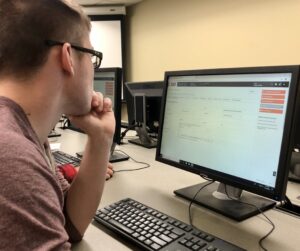
Sharing tech: Meeting jobsite needs with classroom partnerships
By Adam Freill
Construction Skills Development Software
Construction software platform Procore is one of a number of industry suppliers working with colleges and universities to train the next generation of workers. (Photo courtesy of Procore and George Brown College)
As the construction industry embraces technology at an incredible pace, so too are the training schools that are preparing the next generation of the industry’s workforce. By working with technology companies, these schools are attracting young people interested in digital applications while preparing them for the realities of modern job sites.
“With our journeyperson training, we’re always trying to add additional technology pieces into it and update how we’re going about teaching,” stated Reva Bond, dean of SAIT’s School of Construction, during a recent interview about the incorporation of Procore’s platform into its programs. She explained that one of the goals is to have students emerge from school ready to roll with the technology skills employers are in need of on their job sites.
“We’re using augmented reality in our trades training, so the apprentices put on their goggles and they can see the whole overlay of the plumbing, for example,” she said, adding that these modern tools increase the speed and accuracy at which students can put things together, leading to better results on trade qualification exams.
“There’s a lot of technology coming along,” concurs Arjun Pandey a professor at George Brown’s Angelo DelZotto School of Construction Management. “We have lots of cutting-edge tools.”
While many of the construction training programs at the college or university levels are software- and brand-agnostic, the ability to partner with suppliers to the industry is providing a number of benefits to all parties in the equation, from the schools, to the students, to the manufacturers, and ultimately to the employers, who are able to hire graduates who know the systems that are actually used on jobsites.
SAIT and George Brown are two of the 11 schools in Canada, and more than 250 around the world, that have partnered to make the Procore platform available to their students.
“I’ve been at SAIT since 2009, and every year our budget gets smaller and smaller. And I have had to say goodbye to software because we just can’t afford it anymore,” said Bond. “What’s fantastic about Procore is its commitment to education. They see the value. We receive the software free of charge, which frees us up to really explore the whole suite and everything it has to offer.”
Students who register through school programs like the one at SAIT gain full access, with full functionality. “Lots of times if you get an educational license, you only have access to bits and pieces and things are turned off. Procore doesn’t do that,” she said. “They recognize that this is a learning space, and to emulate the real world you need access to everything.”
That starts with becoming certified in the program.
“They can certify themselves as a certified proper user,” explained Pandey. “And once they have it they come into the class, they can create RFI and their assignments.”
He sees access to the software as a win-win. “We are helping Procore by teaching the students who then go to job sites where they ask for the technology. The other side is that Procore is giving us the free licenses so that we can use it and practice. It is a good partnership example.”
“Recognizing this opportunity to donate our software to colleges and universities that had construction management programs – all of the credit goes to our customers, who were making us keenly aware of the time and energy they had to spend onboarding new hires,” stated Sasha Reed, director of industry advancement at Procore.org “It was really at the request of our customers to get our software not only in front of universities and colleges, but really to get us into the curriculum … so that students would graduate Procore-ready.”
This ability to be ready to roll for an employer is paying off for some SAIT students, says Bond. “When I’ve seen them graduate … they’re being put into quite high BIM coordinator roles,” she stated.
“The intention really is if we can have the professors have access to the technology, as they’re teaching the principles around construction management, there’s a technology component that’s introduced fairly early,” said Reed. “That should do two things: one, it excites students about getting involved in a career that shows some sustainability into the future by having technology as a component, but I think the second piece too, is really reducing the burden of on ramping once you get into that new role.”




